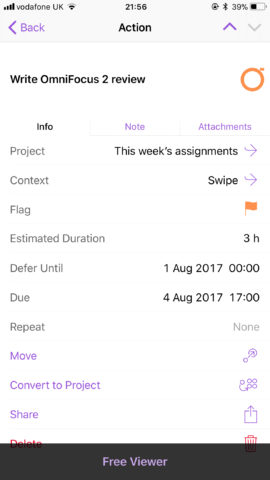It carries a big price tag, but a new two-week free trial could help you decide if OmniFocus 2 deserves a space on your Home screen
Price: Free trial (£38.99 for the standard upgrade)
Version: 2.20.1
Size: 84.9 MB
Developer: The Omni Group
Platform: iPhone, iPad and Apple Watch
The Omni Group has long provided quality software for the Mac and, more recently, iOS platforms. OmniFocus 2, the company’s latest “Get Things Done” offering, brings a plethora of task management features to iOS, yet at the same time is one of the most costly to-do apps on the App Store. However, the application now ships with a two-week free trial, making it the perfect time to consider a full-on purchase. So, does OmniFocus 2’s functionality and feature set justify its price?
When it comes to task management in OmniFocus, three core areas determine how individual items are processed: due date, project, and context. Of course, due dates set a deadline for individual tasks. Projects and contexts are more interesting: the former allows users to link related to-do items together to create a string of tasks; on the other hand, context-related tasks will have places assigned to them for easier processing. You might set a context of “Office” or “Home” to a to-do item; through doing so, you can more easily see when a task should be completed. Usefully, OmniFocus has a Location interface which lets users view their tasks geographically, although this isn’t something many users are going to require.

The OmniFocus 2 main screen: here you can see the Forecast interface (at the top of the screen), as well as virtual buttons for all of OmniFocus’s main areas.
These features did once set OmniFocus apart from the competition, but it didn’t take long for other, less expensive apps to incorporate such functionality. Appigo’s $4.99 Todo includes projects and contexts, for example, and many similar apps do too.
So is there anything else to OmniFocus which justifies the price? The unique Forecast interface is nice, allowing users to quickly check on upcoming tasks, and the Review screen (which is something of an OmniFocus favorite) does let iOS users see all of their projects in an at-a-glance interface. This makes it easy to prune off any tasks which are no longer relevant. It’s also possible to add plenty of detail to individual to-do items in OmniFocus, including notes and attachments.

New tasks can be as detailed (or as sparsely detailed) as you like. Attachments can add extra layers of information.
There are also many smaller power features in OmniFocus which could sway you. The Omni Group’s Mail Drop lets users email tasks into OmniFocus, which is handy – especially if you don’t have your iPhone or iPad nearby when new task surfaces. You can also reorder projects for a more streamlined setup. There’s a dark mode, and the Omni Sync Server will ensure your tasks are synced up between all devices – including the desktop edition of OmniFocus. Plus, the app’s general interface is well designed, minimalistic, easy to use.

The general interface in OmniFocus is great: it’s minimalistic and offers everything you need within reach.
There’s no doubt that OmniFocus 2 is a great app. Indeed, it’s hard to fault it. But does it justify its overall cost? Only you can be the judge of that. After going between OmniFocus and similar to-do apps for years now, there’s little which really sets this costly software apart, aside from its overall polish and reliability. It seems now more than ever that many of the features which once set OmniFocus apart aren’t as unique as they used to be.

